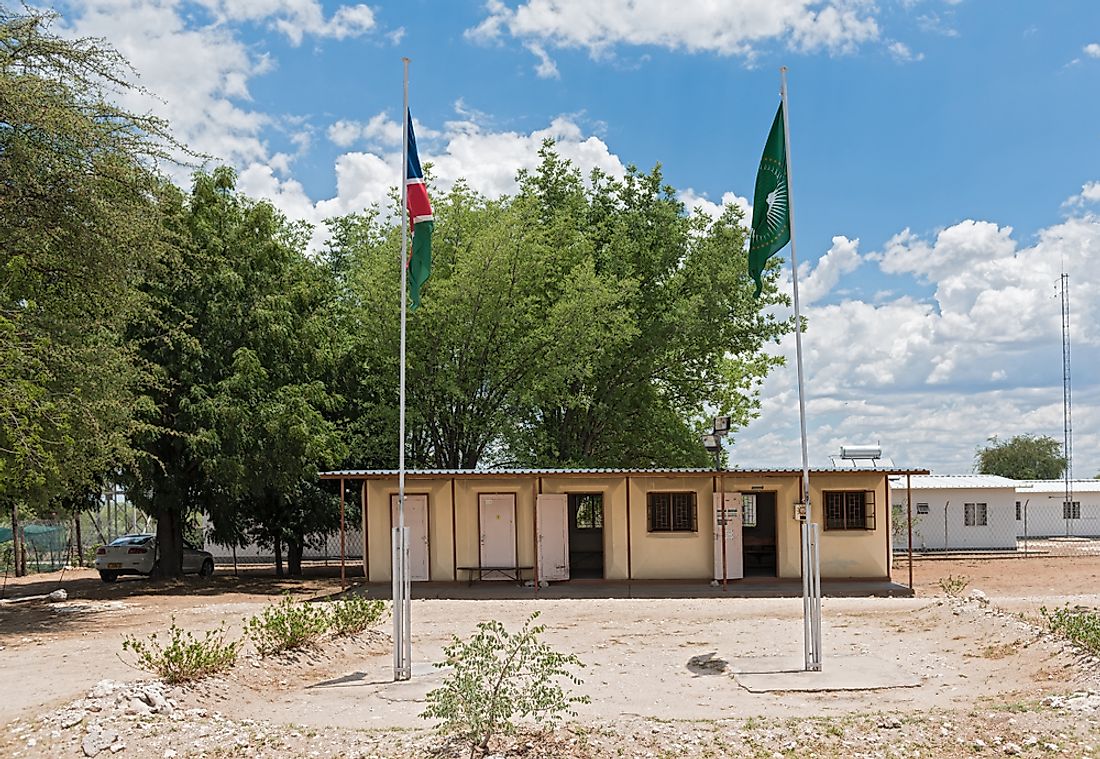Which Countries Border Botswana?

Botswana is a country located in Southern Africa. The country covers a total area of 224,610 square miles, and the majority of this area is land, while only about 6,000 square miles are water. Botswana has a population size of approximately 2.25 million, and 79% of this total identify as ethnic Tswana. One of the most widely spoken languages is Setswana, although English is recognized as the official language of the country.
Botswana is a landlocked country, which means that its 2,701.19 mile border does not run along an open ocean or sea. Geographically, the country consists of three regions: the Kalahari Desert, the Makgadikgadi Pans (a large salt flat), and the Okavango Delta (a large interior river delta). Politically, Botswana is divided into nine districts.
Botswana shares borders with four other countries: South Africa, Zimbabwe, Zambia, and Namibia. This article highlights these international boundary lines.
What Countries Border Botswana?
South Africa
The border between South Africa and Botswana is 1,223 miles in length, making it Botswana's longest international border. South Africa is located south of Botswana, and the two countries share 15 official border crossing sites, making travel between the two relatively easy. Additionally, the border between the two countries follows the course of several rivers, including: the Limpopo River, the Marico River, the Nossob River, and the Molopo River.
At the eastern point of this boundary, where Botswana and South Africa meet Zimbabwe, the border runs in a western direction, following the Limpopo River (which joins the Shashe River just before entering Zimbabwe). Further southwest, the Limpopo River ends at the confluence of the Marico River and Crocodile River. From this point, the border between Botswana and South Africa runs along the course of the Marico River and continues in a westward direction. Near the city of Gaborone, Botswana, where the reservoir feeds into the Notwane River (also known as the Ngotwane River), the border takes a sharp turn south before turning in a westward direction once again, following the Molopo River for much of the way. The border then turns in a northwestern direction, following the Nossob River through Kgalagadi Transfrontier Park. The majority of the park is situated within Botswana. The border eventually ends where Botswana and South Africa meet Namibia.
Zimbabwe
The border between Botswana and Zimbabwe runs for a length of 518 miles along the northeastern edge of Botswana. Approximately 60% of the boundary is separated by a long barbed wire fence, which has an exact length of 310 miles and stands at a height of 6 feet. The fence was erected and funded by the government of Botswana in 2003 and is said to be connected to an electric current, although a BBC report from 2009 indicated that the fence had not been electrified at that time. The reason for this physical barrier is disputed. According to the government of Botswana, the fencing was put into place to prevent livestock from crossing freely between the two countries. In the early 2000s, multiple cases of foot and mouth disease were discovered in the two nations and the source of the disease was traced to cattle. The disease caused the loss of thousands of heads of cattle in Botswana, which is significant because livestock agriculture is the second largest contributor to the country's national gross domestic product (GDP). However, neither government sends guards to patrol the fence, which is obstructed by rivers along several points. These river crossings are easily passed by grazing cows, a fact that the government of Zimbabwe highlights when disputing the need for the fence. According to the government of Zimbabwe, the authorities in Botswana have erected the fence in order to prevent undocumented Zimbabwean immigrants from entering the country.
Botswana and Zimbabwe share several official border crossing posts, the most recent of which opened in 2016. This new border crossing, known as the Mlambapeli Border Post, was created in an effort to reduce the amount of traffic found at the border crossing known as Plumtree.
Zambia
The border between Botswana and Zambia runs for a total of 0.093 miles, making it the shortest international border in Botswana. This small stretch of the boundary sits at the northernmost point in Botswana, where the peninsula region of Namibia meets Zimbabwe, Botswana, and Zambia. The border is unique in that four countries nearly converge, although not all of their borders touch.
The town of Kazungula sits on Zambia's side of the border, in the Southern Province, and is separated from the village of Kazungula in Botswana by the Zambezi River, which has a width of 1,300 feet at that point. Individuals can move between the two countries by the Kazungula Ferry, which is one of the biggest ferry services in Southern Africa. The ferry is able to transport approximately 70 tonnes of weight. The governments of each country have also agreed to invest in the construction of a bridge that would connect Sesheke Road and Livingstone Road.
Namibia
The border between Namibia and Botswana runs for a total of 959 miles, and is located along the western and northern edges of Botswana. The boundary represents the second longest international border in Botswana. The western edge of the border runs north-south in a straight line from the end of the panhandle of Namibia. In the west, where Route A2 meets Route A3 in Botswana, the border turns sharply to the west in a straight line. The line continues just past the town of Buitepos, Namibia. At this point, the border turns in a southern direction once again and continues in a straight line and forms the western edge of Kgalagadi Transfrontier Park. The border ends at the edge of South Africa.







